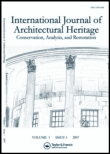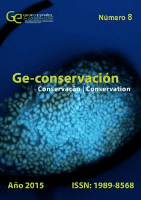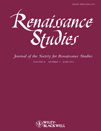
Zograf
Scope & Guideline
Fostering academic excellence in the heart of Serbia.
Introduction
Aims and Scopes
- Eastern Christian Art and Iconography:
Focuses on the study of religious artwork, particularly icons, frescoes, and mosaics, emphasizing their historical, cultural, and theological significance. - Architectural Heritage:
Investigates the architectural developments and styles of churches and monasteries, analyzing their historical context and construction methods. - Cultural Interactions and Influences:
Explores the interactions between Byzantine art and Western European artistic traditions, highlighting the exchange of ideas, techniques, and iconography. - Historical Contextualization:
Provides insights into the historical and cultural contexts of artworks, including the societal, political, and religious factors influencing their creation. - Preservation and Conservation:
Addresses issues related to the preservation of medieval artworks and architectural sites, advocating for their conservation and study.
Trending and Emerging
- Detailed Iconographic Studies:
There is an increasing emphasis on in-depth iconographic analysis of specific artworks, revealing nuanced interpretations and rich historical narratives. - Regional Studies of Art and Architecture:
A notable trend towards focusing on specific geographic regions within the Eastern Christian world, such as Albania and Serbia, highlights the diversity and richness of local traditions. - Interdisciplinary Approaches:
Emerging publications are increasingly adopting interdisciplinary methodologies, incorporating perspectives from anthropology, history, and theology to provide a more holistic understanding of artworks. - Documentation of Lesser-Known Sites:
A growing interest in documenting and analyzing lesser-known churches and monasteries is evident, contributing to a more comprehensive understanding of the region's artistic heritage. - Cultural Heritage and Identity:
Recent articles explore the intersection of art, cultural heritage, and identity, particularly in the context of post-Byzantine societies, reflecting contemporary concerns about the preservation of cultural narratives.
Declining or Waning
- Western Artistic Influence on Eastern Traditions:
Although the journal has explored the interactions between Western and Eastern art, recent publications suggest a waning focus on this theme, possibly due to a shift towards more localized studies. - Modern Interpretations of Medieval Art:
There seems to be a decline in papers that tackle modern interpretations and contemporary relevance of medieval art, indicating a potential move away from applying modern frameworks to historical analysis. - Theoretical Approaches to Iconography:
The journal has seen fewer contributions that engage deeply with theoretical frameworks for interpreting iconography, suggesting a shift towards more straightforward historical and descriptive analyses.
Similar Journals

International Journal of Architectural Heritage
Connecting Scholars to Safeguard Cultural Heritage.The International Journal of Architectural Heritage is a premier publication dedicated to the multidisciplinary fields of architecture, conservation, and visual arts. Published by TAYLOR & FRANCIS INC, this journal serves as a vital platform for scholars and practitioners who aim to advance knowledge in the preservation of cultural heritage and architectural innovation. With an impressive impact factor reflecting its critical acclaim, including rankings in the top quartile (Q1) across multiple categories in 2023, the journal is recognized as a key resource in Arts and Humanities, particularly in Visual Arts and Performing Arts and Conservation. Since its inception in 2007, the journal has consistently provided rigorous peer-reviewed research, offering enriching insights and fostering collaborations amongst students, researchers, and professionals committed to the future of architectural heritage. As it continues to influence the field through its diverse and impactful contributions, readers can expect to engage with leading-edge studies that not only illuminate current trends but also inspire innovative practices in safeguarding architectural legacies.

ARTIBUS ASIAE
Elevating Academic Discourse in the ArtsARTIBUS ASIAE, published by ARTIBUS ASIAE, is a distinguished journal focused on the fields of Archeology and Visual Arts and Performing Arts. Based in Switzerland and with a history of converged years from 2002 to 2024, this journal serves as a vital platform for scholarly discourse and research dissemination within the arts and humanities. Although it currently does not offer open access, ARTIBUS ASIAE maintains a commitment to academic integrity and quality, as evidenced by its presence in Scopus rankings, which places it in the Q4 tier for both Archeology and its niche in the arts and humanities, while achieving a Q3 ranking in Visual Arts and Performing Arts. With an emphasis on advancing knowledge and understanding across various disciplines, ARTIBUS ASIAE is an essential resource for researchers, professionals, and students seeking to enrich their understanding and contribute to the ongoing dialogue in these significant areas of study.

Taida Journal of Art History
Fostering scholarly dialogue on Taiwan's vibrant art scene.Taida Journal of Art History, published by NATIONAL TAIWAN UNIVERSITY, GRADUATE INSTITUTE OF ART, is a pioneering academic journal dedicated to the exploration and critique of art history, particularly within the unique cultural context of Taiwan. Since its inception in 2018, the journal has become an important platform for scholarly discourse, offering insights into the evolution of visual arts and performing arts, alongside comprehensive studies in history. With an ISSN of 1023-2095, it currently ranks within the Q4 category in Arts and Humanities (Miscellaneous) and the Q3 category in History and Visual Arts and Performing Arts, indicating its growing influence in these fields. Researchers, professionals, and students alike can benefit from its rigorous peer-reviewed articles that bridge theoretical frameworks with practical applications, making it an essential resource for those engaged in the arts and humanities. This commitment to fostering academic excellence is reflected in its Scopus rankings, where it stands at Rank #338/667 in Visual Arts and Performing Arts and Rank #1027/1760 in History. Engage with the Taida Journal of Art History to gain deeper insights into the evolving narratives of artistic expression.

Ge-Conservacion
Exploring New Frontiers in Visual and Performing Arts ResearchGe-Conservacion, published by GRUPO ESPANOL I I C, stands as a pivotal journal in the fields of Conservation, Museology, and Visual Arts and Performing Arts, facilitating an open-access platform since 2009. Based in Spain, this journal serves as a vital repository for innovative research and scholarly dialogue, significantly impacting the community with its Q1 and Q2 rankings across several categories in 2023. With an objective to advance multidisciplinary understanding and practices related to cultural heritage conservation, it attracts a diverse readership of researchers, professionals, and students eager to engage with contemporary issues and methodologies. The journal's commitment to accessibility enhances its reach and influence, making it an essential resource for anyone passionate about preserving the integrity and significance of our artistic and historical treasures.

MITTEILUNGEN DES KUNSTHISTORISCHEN INSTITUTES IN FLORENZ
Cultivating knowledge at the nexus of history and creativity.MITTEILUNGEN DES KUNSTHISTORISCHEN INSTITUTES IN FLORENZ, published by LIBRERIA SALIMBENI, is a prestigious journal based in Germany that serves as a vital resource for scholars and practitioners in the fields of history, visual arts, and performing arts. With an ISSN of 0342-1201, this journal reflects significant academic excellence, as evidenced by its Scopus rankings, placing it in the second quartile (Q2) for both History and Visual Arts and Performing Arts in 2023. The journal covers a broad scope from 2002 to 2010 and from 2013 to 2023, focusing on interdisciplinary studies that bridge historical context with contemporary artistic practices. Although not open access, MITTEILUNGEN continues to contribute important insights and critical discourse, making it an essential read for researchers, professionals, and students committed to advancing knowledge in these dynamic fields.

Iconographica
Illuminating Insights in Visual and Performing ArtsIconographica is an esteemed journal published by SISMEL EDIZIONI GALLUZZO, dedicated to the exploration of cultural narratives through visual arts and performing arts. Based in Italy, this journal has been providing a platform for scholarly discourse from 2015 to 2023, and it serves as an important resource for researchers, professionals, and students interested in these interdisciplinary fields. Although indexed in the Q4 quartile for both Cultural Studies and Visual Arts, this journal offers valuable insights that encourage the examination and understanding of visual culture. While currently operating without an open access model, its rigorous peer-review process ensures high-quality academic contributions that reflect the evolving dynamics within these areas of study. Set against the backdrop of a rapidly transforming cultural landscape, Iconographica aims to foster engagement, inspire innovative perspectives, and cultivate a deeper appreciation for the interplay between culture and visual representation.

GESTA-INTERNATIONAL CENTER OF MEDIEVAL ART
Unveiling the Beauty of the Medieval EraGESTA-INTERNATIONAL CENTER OF MEDIEVAL ART is a distinguished journal published by University of Chicago Press, focusing on the intricate and rich tapestry of medieval art. With the ISSN 0016-920X and E-ISSN 2169-3099, it serves as a vital resource for scholars and enthusiasts alike, examining the evolution and influence of visual arts during the medieval period. This journal is indexed in Scopus, showcasing its ranking of #188 out of 667 in the field of Arts and Humanities, placing it within the 71st percentile. Moreover, it holds a notable Q3 categorization in Visual Arts and Performing Arts as of 2023, reflecting its significant contribution to academic discourse. Although it is not an open-access journal, GESTA provides invaluable insights and critical analyses that engage a broad audience including researchers, professionals, and students dedicated to medieval studies. With publication converging from 2002 to 2006 and continuing from 2008 to 2024, GESTA is committed to promoting a deeper understanding of art's historical contexts, making it an essential addition to any academic library.

REVUE DE L ART
Cultivating Critical Theories in Artistic ResearchREVUE DE L'ART, published by EDITIONS C N R S, is a significant scholarly journal that focuses on the diverse realms of visual arts and performing arts. With an ISSN of 0035-1326, the journal serves as a vital forum for researchers, professionals, and students, engaging them in contemporary discourses surrounding artistic practices and critical theories. While it currently holds a Q4 ranking in the Visual Arts and Performing Arts category for 2023, with a Scopus ranking of #578 out of 667, REVUE DE L'ART emphasizes the importance of innovative research and interdisciplinary studies in the arts. Although it is not an open access publication, the journal ensures that high-quality scholarship remains accessible to professionals and student communities in France and beyond. The journal’s commitment to artistic investigation and analysis continues to contribute significantly to the understanding of art within historical and contemporary contexts, making it a crucial resource for anyone engaged in these fields.

Bulletin KNOB
Bridging Heritage and InnovationBulletin KNOB, published by the KONINKLIJKE NEDERLANDSE OUDHEIDKUNDIGE BOND-KNOB, is a reputable Open Access journal that has been disseminating knowledge since 1899, with a continued commitment to making research accessible to all. Based in the Netherlands, this journal provides a platform for scholarly articles that span the fields of Conservation, History, and the Visual Arts and Performing Arts. With its 2023 Scopus rankings placing it in the top quartiles within its category, Bulletin KNOB is recognized for its significant contribution to the advancement of these disciplines. Researchers, professionals, and students alike are encouraged to engage with the journal's diverse content that bridges historical narratives with contemporary practices, fostering a deeper understanding of cultural heritage. The journal’s commitment to excellence is further reflected in its Q3 and Q4 quartile rankings, making it an essential resource for anyone dedicated to the study of the arts and humanities.

Renaissance Studies
Fostering Interdisciplinary Insights into the RenaissanceRenaissance Studies, published by Wiley, stands as a vital academic platform within the disciplines of Cultural Studies, History, Literature and Literary Theory, Religious Studies, and Visual Arts and Performing Arts. With an impressive history of publication spanning from 1987 to 2024, this journal is recognized in 2023 metrics as a Q2 journal in four categories and Q1 in Literature and Literary Theory, reflecting its substantial impact in promoting interdisciplinary dialogue and research. The journal's robust Scopus rankings further underscore its relevance, including a position in the 83rd percentile in Literature and Literary Theory. Although not an open-access journal, it provides readers and contributors with access to curated, high-quality scholarship that explores the complexities of the Renaissance and its enduring influence on contemporary thought and culture. Researchers, professionals, and students alike will find Renaissance Studies invaluable in fostering discussions that bridge historical context with modern inquiry.